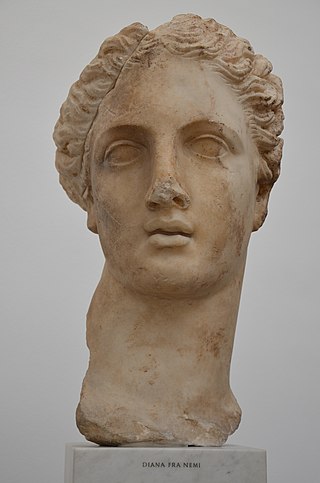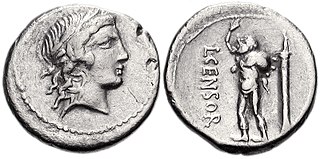
In 82 BC, a denarius was minted by Lucius Marcius Censorinus picturing Apollo and Marsyas the satyr. The coin has attracted several interpretations because of the ambiguity of its symbolism. [2]

In 82 BC, a denarius was minted by Lucius Marcius Censorinus picturing Apollo and Marsyas the satyr. The coin has attracted several interpretations because of the ambiguity of its symbolism. [2]
On the obverse of this coin is a representation of the god Apollo, portrayed as a young man wearing a diadem. On the reverse of the coin is an image of the satyr Marsyas, nude, carrying a wineskin. [2] He is wearing a Phrygian cap, and has a pedestal standing beside him, holding a statue, which some think is a statue of Minerva. [3] Along the side is the inscription L. Censor. [2] The image of Marsyas may be copied from a statue in the Roman Forum at this time, as implied by the pedestal in the field of the coin. [4] The coin is silver and weighs roughly 3.95 grams. [2]
The symbolism may refer to the moneyer’s family line, the gens Marcia, who claimed legendary descent from Marsyas. [5] An ancestor claimed to have experienced a vision which led to the founding of games in tribute to Apollo. The brother of Lucius, Gaius Marcius Censorinus, minted a coin with the image of Apollo. [6]
Another view of the symbolism in this coin is that it is politically driven. [7] Apollo was seen as a symbol of harmony, especially in his manifestation at Rome. [8] During this time, Rome was experiencing a period of political upheaval, connected to the Social Wars. [8] Marsyas was regarded as a symbol of political freedom, particularly free speech. On the coin, Marsyas is wearing a Phrygian cap, a symbol of liberty. [9]
L. Marcius Censorinus was a supporter of Marian or Cinnan politics, which advanced the cause of Roman citizenship for Italians during the Social Wars. [10] Gaius Marcius Censorinus was captured at the Battle of the Colline Gate and beheaded by an order of Sulla, the champion of the Senate's traditional privileges. [11] Many other supporters of Marian politics used images of Apollo on their coins, often in conjunction with images of Saturn, Venus and a god who is known as a young[ clarification needed ] Jupiter. [12]
The image of Apollo on the coin may refer to the plague of 87 BC. Censorinus may have been invoking the god in his capacity as a healer and protector. [13]
Lucius Cornelius Cinna was a four-time consul of the Roman republic. Opposing Sulla's march on Rome in 88 BC, he was elected to the consulship of 87 BC, during which he engaged in an armed conflict – the Bellum Octavianum – with his co-consul, Gnaeus Octavius. Emerging victorious, Cinna initiated with his ally, Gaius Marius, murders of their enemies. In the aftermath, he dominated the republic for the next three years, serving continuously as consul.

In Greek mythology, the satyr Marsyas is a central figure in two stories involving music: in one, he picked up the double oboe (aulos) that had been abandoned by Athena and played it; in the other, he challenged Apollo to a contest of music and lost his hide and life. In antiquity, literary sources often emphasize the hubris of Marsyas and the justice of his punishment.

Antiochus XI Epiphanes Philadelphus was a Seleucid monarch who reigned as King of Syria between 94 and 93 BC, during the Hellenistic period. He was the son of Antiochus VIII and his wife Tryphaena. Antiochus XI's early life was a time of constant civil war between his father and his uncle Antiochus IX. The conflict ended with the assassination of Antiochus VIII, followed by the establishment of Antiochus IX in Antioch, the capital of Syria. Antiochus VIII's eldest son Seleucus VI, in control of western Cilicia, marched against his uncle and had him killed, taking Antioch for himself, only to be expelled from it and driven to his death in 94 BC by Antiochus IX's son Antiochus X.
Roman Republican currency is the coinage struck by the various magistrates of the Roman Republic, to be used as legal tender. In modern times, the abbreviation RRC, "Roman Republican Coinage" originally the name of a reference work on the topic by Michael H. Crawford, has come to be used as an identifying tag for coins assigned a number in that work, such as RRC 367.
Gnaeus Octavius was a Roman senator who was elected consul of the Roman Republic in 87 BC alongside Lucius Cornelius Cinna. He died during the chaos that accompanied the capture of Rome by Cinna and Gaius Marius.
Quintus Caecilius Metellus Pius was a general and statesman of the Roman Republic. His father Metellus Numidicus was banished from Rome through the machinations of Gaius Marius. He, because of his constant and unbending attempts to have his father officially recalled from exile, was given the agnomen (nickname) Pius.

The gens Marcia, occasionally written Martia, was one of the oldest and noblest houses at ancient Rome. They claimed descent from the second and fourth Roman Kings, and the first of the Marcii appearing in the history of the Republic would seem to have been patrician; but all of the families of the Marcii known in the later Republic were plebeian. The first to obtain the consulship was Gaius Marcius Rutilus in 357 BC, only a few years after the passage of the lex Licinia Sextia opened this office to the plebeians.

Diana Nemorensis, also known as "Diana of the Wood", was an Italic form of the goddess who became Hellenised during the fourth century BC and conflated with Artemis.
Gaius Valerius Flaccus was a Roman general, politician and statesman. He was consul of the Roman Republic in 93 BC and a provincial governor in the late-90s and throughout the 80s. He is notable for his balanced stance during the Sullan civil wars, the longevity of his term as governor, and his efforts to extend citizenship to non-Romans.
Lucius Valerius Flaccus was a consul of the Roman Republic in 100 BC and princeps senatus during the civil wars of the 80s. He is noted for his peace initiatives, which failed, and for sponsoring the Lex Valeria that created the dictatorship of Sulla.
Lucius Valerius Flaccus became suffect consul of the Roman Republic in 86 BC when Gaius Marius, the consul prior, unexpectedly died. He was elected to complete Marius's term in office. Marius had fought a series of civil wars against Lucius Cornelius Sulla, both leaders of their respective factions: the populares and the optimates. Flaccus was considered a staunch supporter of Marius and Lucius Cornelius Cinna; the leaders of the Marian-Cinna faction within the populares. Cinna was Marius's consular collegae and succeeded Marius as faction leader.

Marcius Censorinus was a name used by a branch of the plebeian gens Marcia of ancient Rome. The cognomen Censorinus was acquired through Gaius Marcius Rutilus, the first plebeian censor, whose son used it. The gens Marcia claimed descent from both Ancus Marcius, a king of Rome, and symbolically from Marsyas the satyr, who was associated with free speech and political liberty; see further discussion at Prophecy and free speech at Rome. The Marcii Censorini were consistent populares, supporting Marius, Cinna, Julius Caesar, and Antonius.
The gens Aburia was a plebeian family at ancient Rome during the latter centuries of the Republic, and the first century of the Empire. The first member of this gens to achieve prominence was Marcus Aburius, praetor peregrinus in 176 BC.
Lucius Marcius Censorinus was a consul of the Roman Republic in 39 BC, during the Second Triumvirate. He and his colleague Gaius Calvisius Sabinus had been the only two senators who tried to defend Julius Caesar when he was assassinated on the Ides of March in 44 BC, and their consulship under the triumvirate was a recognition of their loyalty.

The gens Plaetoria was a plebeian family at ancient Rome. A number of Plaetorii appear in history during the first and second centuries BC, but none of this gens ever obtained the consulship. Several Plaetorii issued denarii from the late 70s into the 40s, of which one of the best known alludes to the assassination of Caesar on the Ides of March, since one of the Plaetorii was a partisan of Pompeius during the Civil War.
Gaius Cocceius Balbus was a Roman politician and military commander who served as suffect consul in 39 BC.
Gaius Marcius Censorinus was a late Roman Republican politician and soldier who participated in the first civil war of the Roman Republic, against Sulla.

The Battle of Sena Gallica took place in April or May of 82 BC during the context of Sulla's Second Civil War in the area around present day Senigallia. The battle pitted the Optimates under the command of Gnaeus Pompeius Magnus, legatus of Lucius Cornelius Sulla Felix against the Populares forces commanded by Gaius Marcius Censorinus who was in turn the legatus of Gnaeus Papirius Carbo. The battle resulted in a decisive Optimate victory. Immediately following the battle, the town was subjected to a brutal sacking by Sulla's victorious forces.

The March on Rome of 88 BC was a coup d'état by the consul of the Roman Republic Lucius Cornelius Sulla, who seized power against his enemies Marius and Sulpicius, after they had ousted him from Rome. It was the first time in Roman history that a general ordered his army to march against the Republic.